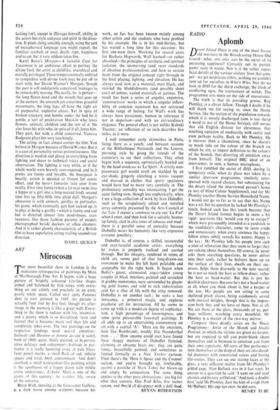ART
Mirocosm
THE most beautiful show in London is the miniature retrospective of paintings by Mira at Marlborough Fine Art. It begins with a huge picture of brightly coloured kite-like shapes joined and balanced by thin wires, with every- thing set out calmly and precisely in an even, pearly white space. Called very aptly Femmes dans la nuit, painted in 1945, the picture is actually four feet by five feet. though its after- image in the memory is like a great wall. Every- thing in the show is radiant with life, invention, and a poetry which is so disciplined, terse and factual that it becomes more real than life and completely takes over. The two paintings on the respective landings need special attention : Solitude and Homme et femme devant le soleil, both of 1960; quiet, thinly painted, of hypersen- sitive delicacy and refinement—Solitude in par- ticular is a really haunting essay in pale blues, faint pencil marks, a small flash of red, infinite spaces and total, final, containment. And don't overlook a small watercolour-like painting which is the apotheosis of a happy dawn with mildly erotic undertones : L'Aube. Miro is one of the giants of this century : he %vatches life, aware of the universe.
Brian Wall, showing at the Grosvenor Gallery, is a dark horse among sculptors because his work, so far, has been known mainly among other artists and the students who have profited by his example. He is in his mid-thirties, but has waited a long time for this occasion : his first one-man show. Working for several years for Barbara Hepworth, Wall learned—or rather absorbed—the principles of aesthetic and spiritual isolation, the unswerving (and rare) standards of absolute professionalism, and how to sustain theM from the original concept right through to the final placing, lighting, and elevation. He has always used iron as a material, matt black, and resisted the blandishments (and possible short cuts) of colour, varied materials or patinas. The result has been a series of angular, expansive, `coustructivist' works in which a singular inflexi- bility of concrete statement has not restricted a wide range of feeling; for Wall's work has always been passionate, human in reference if not in depiction—and with an extraordinary elegance. The general effect is not unlike Kabuki Theatre : an inflection of an inch describes five miles, as it were.
I well remember early skirmishes in Paris, living there as a youth; and between sessions at the Bibliotheque Nationale and the Louvre, pursuing style by going the rounds of the couturiers to see their collections. They often began with a sequence, optimistically bawled out by the head vendeuse as `Le Sport.' A strictly non- pneumatic girl would stroll on shielded by an eye-shade, gingerly clutching a tennis racquet and dressed in clothes that sports spectators would have had to move very carefully in. The preliminary unreality was intoxicating. I get the same feeling now, though less euphorically, when I see a large collection of work by Jean Dubuffet, such as the scrupulously edited and installed array currently presented by the Arts Council at the Tate. I expect a vendeuse to cry out `La Vie!' when I enter, and then look for a suitably beaten- up family, clad in chic tones of tobacco and mud : there is a parallel sense of unreality because Dubuffet wears his humanity like very expensive costume jewellery.
Dubuffet is, of course, a skilful, resourceful and ever-tasteful academic artist : everything he makes is properly realised and carried through. But his imagery, rendered in terms of child art, seems part of that long-drawn-out movement to make the left bank palatable and acceptable for the right bank. It began when Buffet's gaunt, attenuated, angst-ridden young couples in bleak interiors, painted and scratched in grubby monotones, were surrounded by gleam- ing gold frames and sold to rich industrialists avid for a slice of life with the sting removed. Dubuffet is on another tack : he seeks a lost innocence, a primeval magic, and explores psychotic art for instruction. All he seems to come up with is a moderate degree of sophistica- tion, a high percentage of knowingness, and some quite pleasurable faux-naff paintings. It all adds up to an entertaining commentary on art with a capital 'A': 'Here are the ancestors, dark like Rembrandt, muddy like Neanderthal man. . . .' How anyone could ever have found these shaggy matrons of Dubuffet frenzied, alarming or obscene beats me: they are quite funny, beautifully painted, and sometimes as limited formally as a New Yorker cartoon. Then there's the 'Here is Space and the Cosmos' section, and you're brought up, irrefutably, against a pastiche of Mark Tobey but blown-up and empty by comparison. The same thing applies to the other pure abstractions : too big for what they contain. tune Paul Klee, five inches square, and they'd all disappear with a dull thud.
BRYAN ROBERTSON










































 Previous page
Previous page